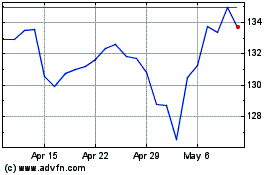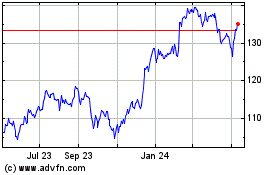- Though rising rates have dampened purchase demand and allowed
for modest inventory growth, a continuing deficit of homes for sale
this spring is helping prices remain resilient
- According to the ICE Home Price Index, prices rose 1.2% in
March, more than 25% above the 25-year average increase, marking
the third consecutive month of above-average home price gains
- On an annual basis, home price growth eased slightly in March
to +5.6% from an upwardly revised +6.0% in February
- Strong home price growth in early 2024 increased
mortgage-holder equity to a record $16.9T in Q1, $11T of which can
be leveraged while retaining a 20% equity cushion – also an
all-time high
- 48M U.S. homeowners with mortgages have some level of such
tappable equity, at an average of $206K per borrower, up from $185K
at the same time last year
- Two thirds of all tappable equity is held by homeowners with
credit scores of 760 or higher, making for a relatively low-risk
lending cohort
- An equal share – two thirds – is held by homeowners with first
lien mortgage rates below 4%, with 84% (~$9.2T) held by those with
rates lower than 5%
- Just five West Coast metros – Los Angeles ($1.1T), San
Francisco ($648B), San Jose ($348B), San Diego ($331B), and Seattle
($324B) – account for nearly a quarter ($2.7T) of total tappable
equity
- Homeowners in these markets not only hold some of the largest
volumes of tappable equity but also have rates well below the
national average as higher loan balances tend to provide more
frequent refi incentive
- Second lien home equity products remain particularly attractive
options for such borrowers wanting to access some of this abundant
equity while maintaining their historically low first lien
rates
Intercontinental Exchange, Inc. (NYSE:ICE), a leading global
provider of technology and data, released its May 2024 ICE Mortgage
Monitor Report, based on the company’s industry-leading mortgage,
real estate and public records data sets.
Though U.S. home price growth slowed modestly on an annual
basis, according to the ICE Home Price Index, March marked the
third consecutive occurrence of above-average monthly gains. Rising
prices combined with higher interest rates have added to the
affordability pressure on prospective homebuyers. Existing
homeowners, on the other hand, continue to reap the benefits of
historically strong price gains. Andy Walden, ICE’s Vice President
of Enterprise Research Strategy, explains.
"The recent trend of rising interest rates has dampened
homebuyer demand and allowed the inventory of homes for sale to
improve,” said Walden. “We’re still very much in a hole from an
inventory perspective, but that deficit has fallen from 50% a year
ago to 38% in March. Today, with 3.3 months of supply, inventory is
still historically low and indicative of a seller’s market. This is
helping to keep home price growth resilient even though demand is
down. In fact, despite some minor slowing, March marked the third
consecutive month of stronger than average growth.”
The ICE Home Price Index for March showed the annual rate of
growth easing slightly from an upwardly revised 6.0% in February to
5.6% in March. Prices were up a seasonally adjusted +0.42% month
over month in March, a pullback from February’s +0.58%. On an
unadjusted basis, however, prices rose +1.2% from the month prior,
more than 25% above the 25-year average gain of +0.96% for the
month of March.
“Such strong price gains continue to plague would-be homebuyers
in today’s higher-rate environment, but for existing homeowners the
picture keeps growing brighter,” Walden added. “Homeowners with
mortgages closed out the first quarter of 2024 with just a hair
under $17T in home equity – an all-time high. Of that, a record
$11T is tappable, meaning available for a homeowner to leverage
while retaining a 20% equity cushion in the property. On average,
that works out to roughly $206K in tappable equity per mortgage
holder.”
In total, approximately 48M mortgage holders have some amount of
tappable equity in their homes that could be accessed even under
relatively conservative combined loan-to-value (CLTV) ratio limits.
From a risk perspective, total market CLTV – the current value of
all mortgaged residential properties against all underlying first
and second lien debt – fell to 44.6% in Q1 2024, down from 45.9%
entering the year. The share of underwater mortgages continued to
dwindle, with fewer than 390K borrowers nationwide (0.72% of all
active loans) owing more than their homes are currently worth.
Overall, two thirds of the nation’s tappable equity is held by
borrowers with credit scores of 760 or higher, making for a
relatively low risk cohort for lenders.
“Just five West Coast markets – Los Angeles, San Francisco, San
Jose, San Diego, and Seattle – account for nearly a quarter of all
tappable equity available,” Walden said. “Not only do these
borrowers hold a cumulative $2.7T in tappable equity, but they also
tend to have first lien interest rates well below the national
average due to more frequent refinance activity among high-balance
loans. The same holds true in other metropolitan areas such as New
York and Washington DC, which account for another $1.1T in tappable
equity. For folks like these, second lien equity products remain a
particularly attractive option for tapping significant amounts of
housing wealth without sacrificing a once-in-a-lifetime low rate on
their existing mortgage.”
Other findings from the ICE Home Price Index for March show the
northeastern U.S. continuing to experience the strongest monthly
price gains, with New Haven (+1.3%) and Hartford, Conn. (+1.1%)
leading the way. Together with the New York City metropolitan area
(+1.0%), Boston, Mass. (+0.9%), Bridgeport, Conn. (+0.9%) and
Allentown, Penn. (+0.8%), these markets notched six of the seven
largest single month price gains among the nation's top 100
metros.
Meanwhile, each of Florida's nine largest markets saw seasonally
adjusted prices edge lower, as for sale inventory has been growing
sharply across the state. Inventory levels in Lakeland, Palm Bay,
Deltona and Cape Coral, Fla. are all back above pre-pandemic
levels, while North Port, Tampa, Orlando and Jacksonville are
within 10% of 2018/2019 norms. Miami inventory has been trending
higher as well, but it remains 27% below pre-pandemic levels.
Much more information on these and other topics can be found in
this month’s Mortgage Monitor.
About Mortgage Monitor
ICE manages the nation’s leading repository of loan-level
residential mortgage data and performance information covering the
majority of the overall market, including tens of millions of loans
across the spectrum of credit products and more than 160 million
historical records. The combined insight of the ICE Home Price
Index and Collateral Analytics’ home price and real estate data
provides one of the most complete, accurate and timely measures of
home prices available, covering 95% of U.S. residential properties
down to the ZIP-code level. In addition, the company maintains one
of the most robust public property records databases available,
covering 99.9% of the U.S. population and households from more than
3,100 counties.
ICE’s research experts carefully analyze this data to produce a
summary supplemented by dozens of charts and graphs that reflect
trend and point-in-time observations for the monthly Mortgage
Monitor Report. To review the full report, visit:
https://www.icemortgagetechnology.com/resources/data-reports.
About Intercontinental Exchange
Intercontinental Exchange, Inc. (NYSE: ICE) is a Fortune 500
company that designs, builds, and operates digital networks that
connect people to opportunity. We provide financial technology and
data services across major asset classes helping our customers
access mission-critical workflow tools that increase transparency
and efficiency. ICE’s futures, equity, and options exchanges --
including the New York Stock Exchange -- and clearing houses help
people invest, raise capital and manage risk. We offer some of the
world’s largest markets to trade and clear energy and environmental
products. Our fixed income, data services and execution
capabilities provide information, analytics and platforms that help
our customers streamline processes and capitalize on opportunities.
At ICE Mortgage Technology, we are transforming U.S. housing
finance, from initial consumer engagement through loan production,
closing, registration and the long-term servicing relationship.
Together, ICE transforms, streamlines, and automates industries to
connect our customers to opportunity.
Trademarks of ICE and/or its affiliates include Intercontinental
Exchange, ICE, ICE block design, NYSE and New York Stock Exchange.
Information regarding additional trademarks and intellectual
property rights of Intercontinental Exchange, Inc. and/or its
affiliates is located here. Key Information Documents for certain
products covered by the EU Packaged Retail and Insurance-based
Investment Products Regulation can be accessed on the relevant
exchange website under the heading “Key Information Documents
(KIDS).”
Safe Harbor Statement under the Private Securities Litigation
Reform Act of 1995 -- Statements in this press release regarding
ICE's business that are not historical facts are "forward-looking
statements" that involve risks and uncertainties. For a discussion
of additional risks and uncertainties, which could cause actual
results to differ from those contained in the forward-looking
statements, see ICE's Securities and Exchange Commission (SEC)
filings, including, but not limited to, the risk factors in ICE's
Annual Report on Form 10-K for the year ended December 31, 2023, as
filed with the SEC on February 8, 2024.
Source: Intercontinental Exchange Category: Mortgage Technology
ICE-CORP
View source
version on businesswire.com: https://www.businesswire.com/news/home/20240506920037/en/
ICE Media Contact Mitch Cohen mitch.cohen@bkfs.com +1
704-890-8158
ICE Investor Contact: Katia Gonzalez
katia.gonzalez@ice.com +1 (678) 981-3882
Intercontinental Exchange (NYSE:ICE)
Historical Stock Chart
From Apr 2024 to May 2024

Intercontinental Exchange (NYSE:ICE)
Historical Stock Chart
From May 2023 to May 2024
